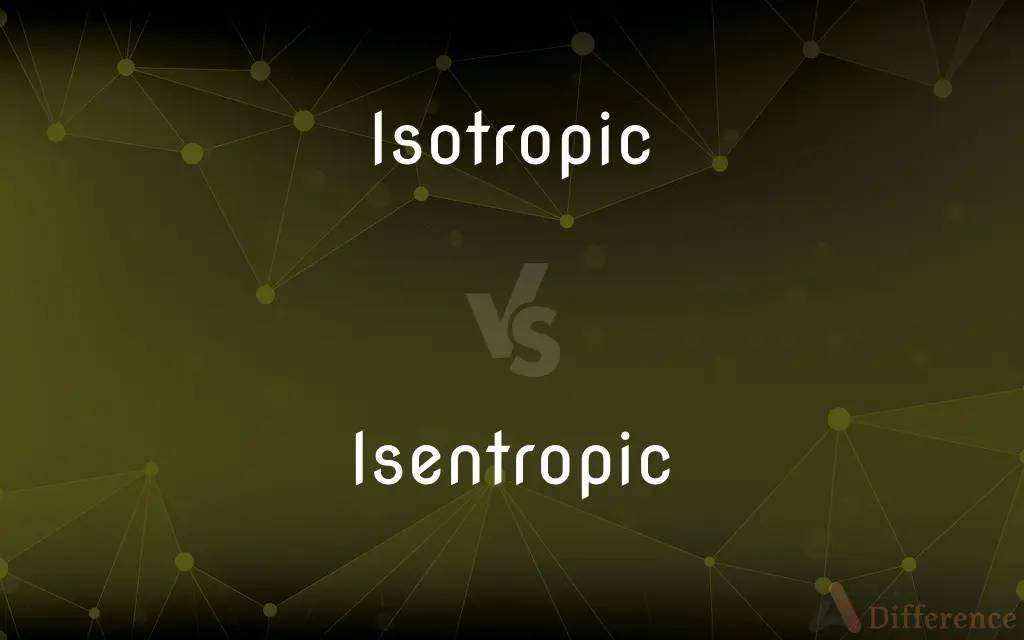Isotropic vs. Isentropic — What's the Difference?
Edited by Tayyaba Rehman — By Urooj Arif — Updated on March 10, 2024
Isotropic materials exhibit uniform properties in all directions, while isentropic processes involve no change in entropy, indicating reversible and adiabatic conditions.

Difference Between Isotropic and Isentropic
Table of Contents
ADVERTISEMENT
Key Differences
Isotropic substances are characterized by their uniformity in physical properties, regardless of the measurement direction. This uniformity can pertain to elasticity, thermal conductivity, or refractive index. Isentropic processes, on the other hand, refer to thermodynamic processes that occur without any change in entropy, often idealized situations where the process is both reversible and adiabatic.
In the context of materials science, isotropy is a critical property for materials like metals, glasses, and fluids that behave the same way physically in all orientations. Isentropic conditions are more about a thermodynamic process's ideal behavior, such as in the expansion or compression of gases where heat transfer is absent, and the process is reversible.
Isotropic materials simplify the design and analysis of structures and devices by ensuring predictable behavior under stress or thermal variations. Meanwhile, isentropic processes are key in designing efficient thermodynamic cycles, such as those in engines and compressors, where minimizing entropy change is crucial for maximizing efficiency.
The concept of isotropy is primarily used in materials science and physics to describe materials' inherent properties. Isentropic processes are central to thermodynamics, particularly in the study of idealized cycles and the efficiency of heat engines.
While isotropy deals with material properties being uniform in all directions, isentropic processes are concerned with the condition where entropy remains constant, reflecting an ideal, reversible, and no heat exchange condition. These principles apply in different contexts but are crucial for understanding material behavior and thermodynamic efficiency.
ADVERTISEMENT
Comparison Chart
Definition
Uniform properties in all directions
No change in entropy
Field of Application
Materials science and physics
Thermodynamics
Key Characteristics
Uniformity in physical properties
Reversible and adiabatic processes
Importance
Simplifies design and analysis
Maximizes efficiency in thermodynamic cycles
Examples
Metals, glass, fluids
Ideal gas expansion and compression
Compare with Definitions
Isotropic
Exhibits uniform properties in all directions.
Glass is isotropic, offering consistent clarity from any angle.
Isentropic
Processes with no change in entropy, indicating reversible and adiabatic conditions.
An isentropic compression in turbines achieves high efficiency.
Isotropic
Essential for materials where directional uniformity is critical.
Metals are often isotropic, ensuring even strength throughout.
Isentropic
Used in the design of efficient engines and compressors.
Isentropic efficiency is a key metric in evaluating turbines.
Isotropic
Influences a wide range of physical properties.
Thermal conductivity is consistent in isotropic materials.
Isentropic
Idealized concept critical in thermodynamics.
Isentropic processes are benchmarks for real-world thermodynamic performance.
Isotropic
Simplifies engineering calculations and designs.
Using isotropic materials reduces complexity in structural designs.
Isentropic
Assumes no heat transfer with the surroundings.
In an isentropic process, a gas expands without gaining or losing heat.
Isotropic
Found in both natural and synthetic materials.
Many crystals are isotropic, displaying uniform optical properties.
Isentropic
Facilitates the analysis of energy systems.
Isentropic models help predict the performance of refrigeration cycles.
Isotropic
Identical in all directions; invariant with respect to direction.
Isentropic
Without change in entropy; at constant entropy.
Isotropic
(physics) Having properties that are identical in all directions; exhibiting isotropy
Isentropic
Having a constant entropy
Isotropic
(maths) Having the same components in all rotated coordinate systems
Isentropic
Having equal entropy.
Isotropic
Having the same properties in all directions; specifically, equally elastic in all directions.
Isentropic
With unchanging entropy; at constant entropy
Isotropic
Invariant with respect to direction
Common Curiosities
What makes a material isotropic?
A material is isotropic if it has uniform properties in all directions, such as thermal conductivity or strength.
Can glass be considered isotropic?
Yes, glass is generally considered isotropic, with uniform optical and physical properties throughout.
Can a process be perfectly isentropic in reality?
In reality, no process is perfectly isentropic due to inevitable friction and heat losses, but it serves as an ideal model.
What role does isentropic efficiency play in refrigeration cycles?
Isentropic efficiency affects the performance and energy consumption of refrigeration cycles, with higher efficiency indicating less wasted work.
Are all metals isotropic?
Many metals are isotropic, but some can exhibit anisotropy due to grain orientation or processing methods.
What are the implications of isotropy in construction?
Isotropy in construction materials ensures predictable performance under load from any direction, simplifying design and safety calculations.
Is it possible to have an isotropic polymer?
Yes, some polymers can be isotropic, especially in their amorphous state, exhibiting uniform properties.
Why is isentropic efficiency important in turbines?
Isentropic efficiency in turbines measures how closely a turbine's performance approaches the ideal, maximizing energy conversion.
Can anisotropic materials be made isotropic?
Through processing techniques like forging or annealing, anisotropic materials can sometimes be made more isotropic.
What is an example of an isentropic process in nature?
True isentropic processes are idealized and rare in nature, but adiabatic expansion of high-altitude air approximates isentropic behavior.
Why is isotropy important in optical materials?
Isotropy ensures consistent light propagation and refractive properties, crucial for lenses and optical devices.
What factors affect a process's isentropic efficiency?
Factors include the design of the system, material properties, operational conditions, and the level of irreversibilities.
How is isotropy tested in materials?
Isotropy is tested through methods like X-ray diffraction, mechanical stress testing, and thermal conductivity measurements to ensure uniform properties.
How do isentropic processes relate to entropy?
Isentropic processes are idealized scenarios where entropy remains constant, indicating no net entropy exchange with the surroundings.
How do isentropic and adiabatic processes differ?
Isentropic processes are both adiabatic and reversible, while adiabatic processes may not be reversible.
Share Your Discovery

Previous Comparison
Mental vs. Intellectual
Next Comparison
Lasso vs. ReataAuthor Spotlight
Written by
Urooj ArifUrooj is a skilled content writer at Ask Difference, known for her exceptional ability to simplify complex topics into engaging and informative content. With a passion for research and a flair for clear, concise writing, she consistently delivers articles that resonate with our diverse audience.
Edited by
Tayyaba RehmanTayyaba Rehman is a distinguished writer, currently serving as a primary contributor to askdifference.com. As a researcher in semantics and etymology, Tayyaba's passion for the complexity of languages and their distinctions has found a perfect home on the platform. Tayyaba delves into the intricacies of language, distinguishing between commonly confused words and phrases, thereby providing clarity for readers worldwide.
















































